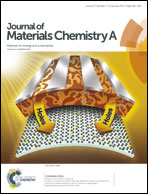Hydrothermal pre-treatment for mesoporous carbon synthesis: enhancement of chemical activation†
Abstract
This work presents a resource-friendly process to produce high surface area mesoporous activated carbons from biomass. ZnCl2 as an activating agent was incorporated into the biomass (coconut shells) during a hydrothermal pre-treatment step. The pre-treatment was followed by pyrolysis accompanied by physical activation. The resultant mesoporous activated carbons possessed a higher total surface area and a greater degree of mesoporosity compared to the biomass that was pyrolysed without hydrothermal treatment. The cause of higher mesoporosity is inferred to be the more conducive environment for accessibility of ZnCl2 due to reduced diffusion resistance to the biomass provided by the hydrothermal treatment. In addition, the hydrothermal environment facilitated the generation of oxygen-containing functional groups that contributed to the enhanced activity of ZnCl2. Up to 67% increase in the mesoporous surface area was achieved with the inclusion of the pre-treatment step. Analogously, 50% more ZnCl2 was required to deliver the same performance in the absence of the pre-treatment step. The mesoporous activated carbons were tested for adsorption of textile dyes and possessed high adsorption capacities of up to 526 mg and 630 mg per g of carbon for methylene blue and erythrosine red, respectively. The incorporation of the hydrothermal pre-treatment is an important step in developing processes for converting biomass that make efficient and effective use of activating agents.


 Please wait while we load your content...
Please wait while we load your content...